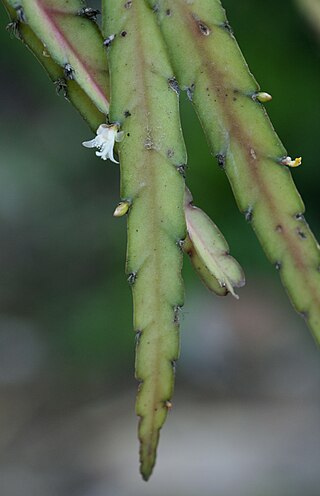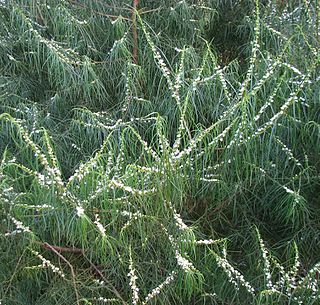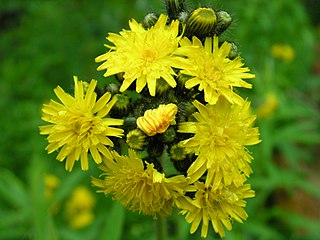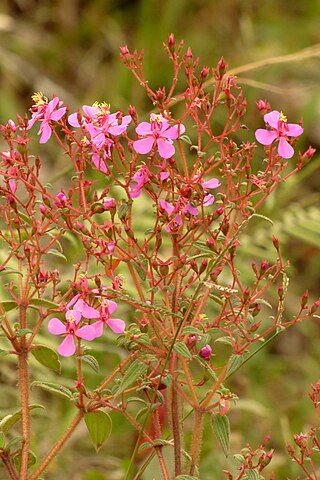
Hieracium , known by the common name hawkweed and classically as hierakion, is a genus of flowering plant in the family Asteraceae, and closely related to dandelion (Taraxacum), chicory (Cichorium), prickly lettuce (Lactuca) and sow thistle (Sonchus), which are part of the tribe Cichorieae. Hawkweeds, with their 10,000+ recorded species and subspecies, do their part to make Asteraceae the second largest family of flowering plants. Some botanists group all these species or subspecies into approximately 800 accepted species, while others prefer to accept several thousand species. Since most hawkweeds reproduce exclusively asexually by means of seeds that are genetically identical to their mother plant, clones or populations that consist of genetically identical plants are formed and some botanists prefer to accept these clones as good species whereas others try to group them into a few hundred more broadly defined species. What is here treated as the single genus Hieracium is now treated by most European experts as two different genera, Hieracium and Pilosella, with species such as Hieracium pilosella, Hieracium floribundum and Hieracium aurantiacum referred to the latter genus. Many members of the genus Pilosella reproduce both by stolons and by seeds, whereas true Hieracium species reproduce only by seeds. In Pilosella, many individual plants are capable of forming both normal sexual and asexual (apomictic) seeds, whereas individual plants of Hieracium only produce one kind of seeds. Another difference is that all species of Pilosella have leaves with smooth (entire) margins whereas most species of Hieracium have distinctly dentate to deeply cut or divided leaves.
A dry roadside dotted with small, ¾ inch red orange flowers, interspersed with very similar yellow ones, and often the white of daisies, is a good sign that you are in Hawkweed country.

Melastomataceae is a family of dicotyledonous flowering plants found mostly in the tropics comprising c. 175 genera and c. 5115 known species. Melastomes are annual or perennial herbs, shrubs, or small trees.

Myoporum is a genus of flowering plants in the figwort family, Scrophulariaceae. There are 30 species in the genus, eighteen of which are endemic to Australia although others are endemic to Pacific Islands, including New Zealand, and one is endemic to two Indian Ocean islands. They are shrubs or small trees with leaves that are arranged alternately and have white, occasionally pink flowers and a fruit that is a drupe.

Lepismium is a genus of mostly epiphytic cacti, with seven species. They are found in tropical South America.

Liabum is a genus of South American flowering plants in tribe Liabeae of the family Asteraceae.
Dendrophorbium floribundum is a species of flowering plant in the family Asteraceae. It is found only in Ecuador. Its natural habitat is subtropical or tropical moist montane forests. It is threatened by habitat loss.
Stylidium floribundum is a dicotyledonous plant that belongs to the genus Stylidium. S. floribundum's distribution ranges from the Kimberley region of Western Australia across northern Australia to northwestern Queensland.
Anonidium is a genus of plant in family Annonaceae.

Lophopetalum is a genus of plants in the family Celastraceae.

Syzygium floribundum, synonym Waterhousea floribunda, is a rainforest tree of eastern Australia. It grows along streams from the Williams River near Dungog to Mackay in central eastern Queensland. Known as the weeping lilli pilli, this tree is widely planted as an ornamental. Planted trees from 1827 may be seen at the Royal Botanic Gardens, Sydney. However, these trees are damaged and threatened by the roosting grey headed flying foxes. A very large tree is located at Western Park in Auckland, New Zealand.

Lasiopetalum floribundum, commonly known as free flowering lasiopetalum, is a species of flowering plant in the family Malvaceae and is endemic to the south-west of Western Australia. It is an erect or spreading shrub with hairy young stems, egg-shaped leaves and pale pink, mauve or white flowers.

Myoporum floribundum, commonly known as weeping myoporum or slender myoporum, is a sour-smelling glabrous shrub in the family Scrophulariaceae endemic to a small area of New South Wales and Victoria in Australia. It has long, thin, drooping leaves and profuse white flowers in clusters along the stems in spring. Although it is uncommon in nature, it has long been available as a popular garden plant.

Clerodendrum floribundum, known as the lolly bush or smooth clerodendrum, is a shrub or tree found in Australia and New Guinea. Its habitat is in or at the margins of coastal rainforests, up to 300 metres above sea level. In Western Australia it grows in drier areas, such as rocky sites, gorges, cliffs, floodplains and creek beds.

Apocynum × floribundum, the intermediate dogbane, is a member of the family Apocynaceae. It is widespread across Canada, the United States, and northern Mexico.

Vaccinium floribundum, commonly known as mortiño or Andean blueberry, is a slender shrub that grows in the northern Andes in Bolivia, Colombia, Ecuador, Peru and Venezuela at elevations from 1,800 to 3,800 metres. It can reach 2–3 m high or it can be dwarf and prostrate. The plant produces an edible fruit, a round berry that is bluish black and glaucous, that is collected and eaten raw and used in preserves. It is sold at some markets and is used for Colada Morada celebrating the Day of the Dead.

Pilosella floribunda is a species of noxious and herbaceous perennial plant from family Asteraceae that is known in Europe and can also be found in United States and Canada. It was believed that it was a hybrid of Pilosella caespitosa (Hieracium caespitosum and Pilosella lactucella.

Monochaetum multiflorum is a flowering plant species in the genus Monochaetum indigenous to Colombia.
Dialypetalum is a genus of plants endemic to Madagascar. It differs from other Lobelioideae in that it has regular (actinomorphic) flowers with virtually free petals, and is dioecious. It contains the following species, accepted as of July 2014:
- Dialypetalum compactumZahlbr.
- Dialypetalum floribundumBenth. in G.Bentham & J.D.Hooker
- Dialypetalum humbertianumE.Wimm. in H.G.A.Engler
- Dialypetalum × hybridumE.Wimm. in H.G.A.Engler(D. compactum × D. floribundum)
- Dialypetalum montanumE.Wimm. in H.G.A.Engler
- Dialypetalum stenopetalumE.Wimm. in H.G.A.Engler

Tetranema is a genus of flowering plants in the family Plantaginaceae, native to Mexico and Central America. There has been some taxonomic debate over its family placement, with Gesneriaceae and Scrophulariaceae having been proposed.

Erisma is a genus of flowering plants belonging to the family Vochysiaceae.
















